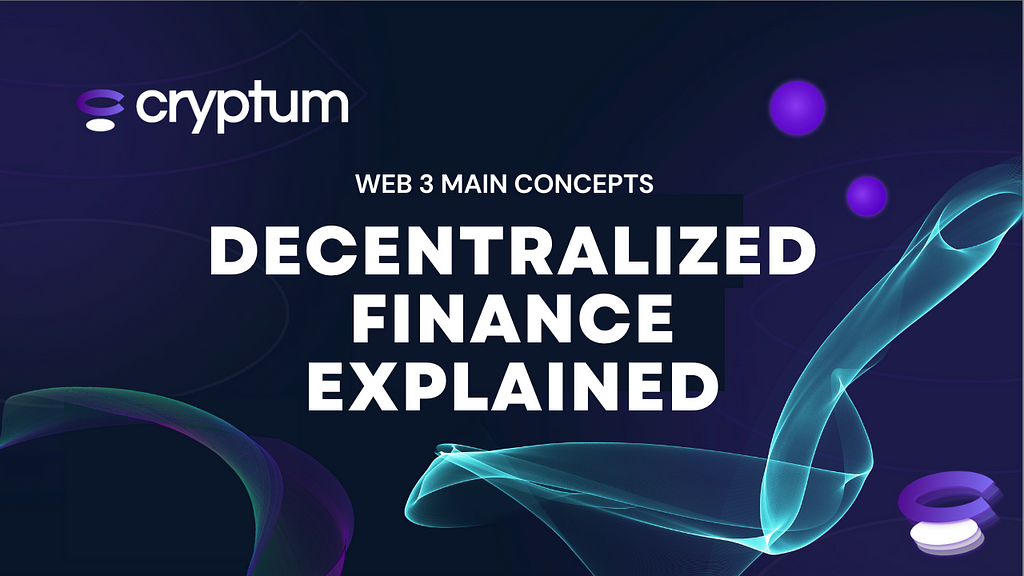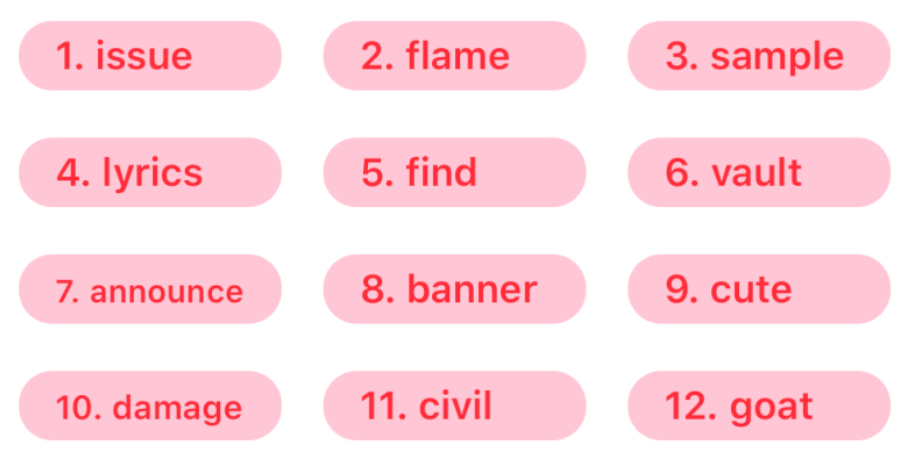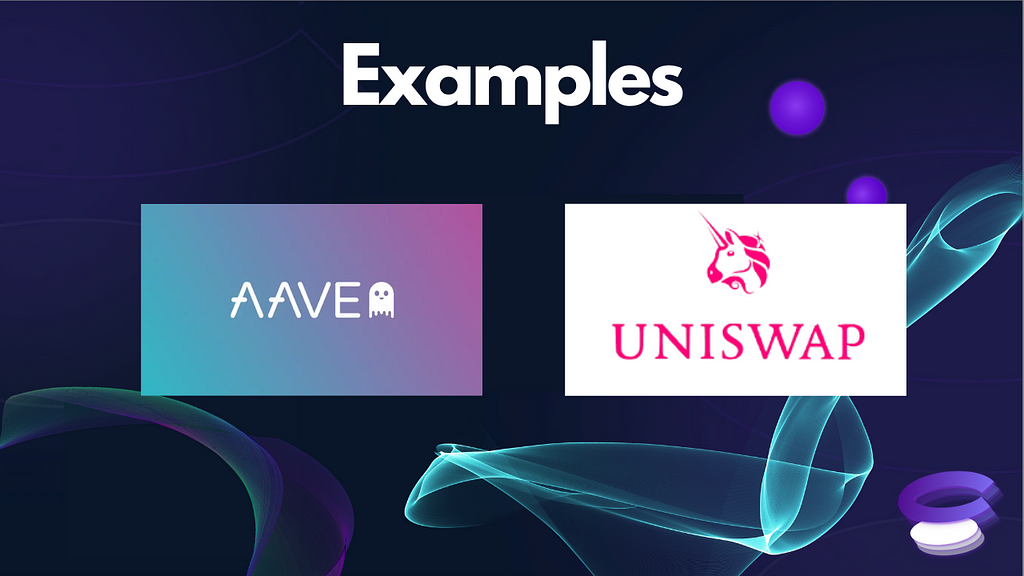Decentralized Finance Explained — Cryptum Web 3 Main Concepts

DeFi is important for several reasons. First, it promotes financial inclusion by enabling people who do not have access to traditional banking services to participate in financial transactions. Second, it offers a safer and more transparent way to conduct financial transactions. Third, DeFi allows for faster and cheaper transactions because there are no intermediaries involved, which can reduce transaction costs and processing times.
DeFi has the potential to disrupt traditional financial systems, create more competition and offer new services that were previously unavailable, Let’s look inside what DeFi is and discover this journey with us.
What you will learn:
- Whats DeFi?
- DeFi Benefits
- DeFi Risks
- DeFi Activities
- DeFi Examples
- Future of DeFi
- Unlock new tokenization opportunities with Cryptum
- What is Decentralized Finance (DeFi)?
In simple terms, let us tell you that DeFi refers to a financial system that operates on a decentralized, blockchain-based network. This means that traditional financial intermediaries such as banks and other financial institutions are eliminated, and transactions occur directly between users.
At its core, DeFi is about building financial systems that operate on decentralized networks such as the Ethereum blockchain. This means that instead of relying on traditional financial institutions such as banks or brokerages, users can access financial services directly through decentralized applications (dApps) that are built on top of these networks.
Some of the key advantages of DeFi include:
- Openness: DeFi applications are open to anyone with an internet connection, regardless of their location or financial status.
- Transparency: DeFi transactions are transparent and auditable, which helps to prevent fraud and increase trust in the system.
- Accessibility: DeFi applications can be accessed 24/7 from anywhere in the world, making it easier for people to access financial services and participate in the global economy.
- Flexibility: DeFi applications can be customized and integrated with other services, which allows for greater innovation and flexibility in the financial system.
- Collaboration: This is a key element of the DeFi ecosystem as it enables different players to leverage each other’s strengths to create better products, funds, and vaults, it can take many forms including partnerships between companies, joint ventures, and open-source development communities. Collaboration in DeFi can take many forms, including partnerships between companies, joint ventures, and open-source development communities. For instance, a DeFi platform may collaborate with a liquidity provider to improve the efficiency of its markets, or a DeFi protocol may partner with a blockchain infrastructure provider to ensure better security and reliability. One notable example of collaboration within DeFi is the concept of yield farming. Yield farming involves staking cryptocurrency in a DeFi protocol to earn rewards in the form of additional tokens. This practice has become increasingly popular in recent years, and it often involves collaboration between multiple DeFi projects
It’s normal to get confused at first, but web3 is all about collaboration, now maybe you are thinking about what perks can you possibly have with DeFi
2. What are the DeFi Benefits?
Take a look at the perks of DeFi:
- Decentralization: DeFi eliminates the need for intermediaries such as banks and other financial institutions. This means that users have more control over their funds and can access financial services from anywhere in the world.
- Transparency: All transactions on DeFi platforms are recorded on a public blockchain, which provides transparency and security. Users can see exactly how their funds are being used and can verify transactions in real-time.
- Lower fees: DeFi platforms have significantly lower fees compared to traditional finance, which can be as high as 10% for some services. This makes it more accessible to people who may not have access to traditional banking services.
- Accessibility: DeFi is open to anyone with an internet connection, which makes it more accessible than traditional finance. This is especially important for people in developing countries who may not have access to traditional banking services
With every benefit you have in DeFi as in any case, you also have some downsides like the risks, let us tell you a few of the risks you can have.
3. DeFi Risks
- Smart contract risk: DeFi relies heavily on smart contracts, which are self-executing code that governs the rules of the platform. If there is a bug or vulnerability in the code, it could lead to a loss of funds.
- Liquidity risk: DeFi platforms rely on liquidity pools to provide users with access to funds. If there is not enough liquidity in the pool, it could lead to slippage and a loss of funds.
- Market risk: DeFi is subject to market volatility, just like traditional finance. If there is a sudden drop in the value of a token or asset, it could lead to a loss of funds.
- Security risk: DeFi platforms are often targeted by hackers who are looking to steal funds. It is important for users to take appropriate security measures to protect their funds.
So now you’ve seen the benefits and risks of this new financial ecosystem, let us explain to you some of the activities DeFi has to offer:
4. DeFi Activities
Wallets:
Crypto Wallet is a key factor to have an identity on the blockchain…
Crypto wallets are essential tools for anyone interested in owning and using cryptocurrencies. They are used to store, send, and receive digital assets like Bitcoin, Ethereum, and other altcoins. Wallets are also your identity on the blockchain. Digging into it, there are two main types of crypto wallets: non-custodial and custodial. This article will explore the differences between these two types of wallets, their advantages and disadvantages, and some examples of each.
- Non-Custodial Wallets
Non-custodial wallets, also known as self-custody wallets, are crypto wallets that give users complete control over their private keys. Private keys sets of words or/and numbers that are used to access and manage cryptocurrency assets. With a non-custodial wallet, you are responsible for keeping your private keys secure, usually through the use of a seed phrase that can be used to recover your wallet in case of loss or theft, let us show you an example:

There are tons of non-custodial wallets, we are going to list a few: MyEtherWallet, MetaMask, and Ledger Nano S. These wallets are popular among crypto enthusiasts because they offer high levels of security and privacy. Since you control your private keys, no third party can access your funds without your permission. Also, non-custodial wallets are usually open-source software, which means that anyone can inspect the code and make sure that it is secure and reliable.
- Custodial Wallets
Custodial wallets are crypto wallets that are managed by third-party companies, such as exchanges or other service providers. With a custodial wallet, you do not have control over your private keys. Instead, the company that manages the wallet stores your private keys on your behalf. You can access your funds through a username and password or other authentication methods.
Examples of custodial wallets include Coinbase, Binance, and Kraken. These wallets are popular among users who value convenience and ease of use. Since the wallet provider manages the private keys, users do not have to worry about keeping them safe. Also, custodial wallets usually offer more user-friendly interfaces and features, such as instant fiat-crypto conversion or trading.
- MPC — Multiparty Computation/ Multisignature
However, there is also a middle ground between these two types of wallets known as a Multi-Party Computation (MPC) or Multisignature (Multisig) wallet. These wallets offer a compromise between the security of a non-custodial wallet and the convenience of a custodial wallet.
MPC wallets are based on advanced cryptography that allows multiple parties to share control of the private keys necessary to access the wallet’s funds. The keys are split into fragments, with each party holding a unique fragment. These fragments are then used to generate a final private key that can be used to access the wallet’s funds.
Multisignature wallets, on the other hand, require multiple signatures to authorize a transaction. For example, a wallet may require two out of three signatures to authorize a transaction, with each signature held by a different party. This approach adds an extra layer of security to the wallet, as a hacker would need to compromise multiple parties to access the funds.
MPC/Multisig wallets offer several benefits over traditional custodial wallets. Firstly, they provide increased security as multiple parties must be compromised to access the wallet’s funds. Secondly, they offer increased control and flexibility, as multiple parties can manage the wallet together. Finally, they offer a middle ground between the convenience of a custodial wallet and the security of a non-custodial wallet.
Despite the benefits, MPC/Multisig wallets are not as widely used as traditional custodial and non-custodial wallets. This is largely due to the complexity of the technology and the fact that they require multiple parties to be involved. However, as the cryptocurrency industry continues to evolve, it is likely that we will see increased adoption of MPC/Multisig wallets as users seek to strike a balance between security and convenience.
Yield Farming
Yield farming is a process in decentralized finance (DeFi) that allows users to earn interest on their cryptocurrency holdings by providing liquidity to a DeFi protocol. In yield farming, users lend or stake* their crypto assets in exchange for rewards, which are paid out in the form of interest or newly minted tokens. The amount of interest earned depends on various factors, such as the amount of liquidity provided, the duration of the lending period, and the current market conditions. Yield farming has become popular among crypto investors due to its potential for high returns, but it also carries risks such as smart contract vulnerabilities and market volatility.
*Stake: Staking in web3 involves holding a cryptocurrency in a web3-compatible wallet and locking it up in a smart contract to support a decentralized network.
DEX (Decentralized Exchange)
A DEX, or decentralized exchange, is a type of cryptocurrency exchange that operates on a decentralized network, rather than a centralized server. It allows users to trade cryptocurrencies without the need for a middleman, such as a centralized exchange. Instead, transactions are facilitated through smart contracts and executed using an automated algorithm. This eliminates the need for a centralized authority to manage trades and provides greater security, privacy, and control over assets. DEXs also offer a wider selection of cryptocurrencies to trade and lower trading fees compared to centralized exchanges. However, they may also have lower liquidity and higher complexity due to their decentralized nature.
Liquidity Mining
Liquidity mining is a process in decentralized finance (DeFi) that allows users to earn rewards by providing liquidity to a DeFi protocol. It involves depositing cryptocurrencies into a liquidity pool, which is used to facilitate trades on a decentralized exchange (DEX). In return for providing liquidity, users receive tokens that represent their share of the pool. These tokens can then be traded or held for further rewards. Liquidity mining incentivizes users to provide liquidity to a DeFi protocol, which helps to maintain a healthy trading ecosystem and facilitates efficient price discovery. It also offers users the potential to earn additional income beyond the traditional rewards from staking or holding cryptocurrencies. However, liquidity mining also carries risks such as smart contract vulnerabilities and market volatility, which can lead to potential losses.
Automated Market Makers (AMMs)
Automated Market Makers (AMMs) are decentralized exchange (DEX) protocols that use mathematical formulas to determine the price of assets traded on their platforms. Unlike centralized exchanges that rely on order books to match buyers and sellers, AMMs use a liquidity pool to facilitate trades. Liquidity providers deposit tokens into the pool and receive liquidity provider (LP) tokens in return, which they can use to reclaim their share of the pool at any time. The price of assets is determined by a simple formula that calculates the ratio of tokens in the pool. When a trade is executed, the token balances in the pool are adjusted automatically, which results in a new price. This automated pricing mechanism ensures that there is always liquidity available for trading, regardless of the volume of trades. AMMs are popular among users who prefer the convenience and lower fees associated with decentralized exchanges. However, they may also have lower liquidity and higher slippage compared to centralized exchanges.
We hope this guide helps you understand the essential part of DeFi, remember, as Cryptum we are not giving financial advice and we are not authorized to tell you what to invest.
Now give a look at these few examples that are participating in this ecosystem:
5. Examples:

Aave: Aave is a decentralized lending platform that allows users to borrow and lend cryptocurrencies. It uses smart contracts to ensure that loans are fully collateralized and that interest rates are determined by market forces rather than a central authority.
Uniswap: Uniswap is a decentralized exchange that allows users to trade cryptocurrencies directly with each other. It uses an automated market maker system to set prices and provide liquidity. This means that anyone can become a liquidity provider and earn fees for facilitating trades on the platform.
Now that you’ve learned some of the examples, let’s start talking about where is this heading.
6. Future of DeFi
You may be wondering, where is this heading? Can this escalate? And the answer is yes.
We can expect to see continued growth in the DeFi ecosystem. As more and more users discover the benefits of decentralized finance, we can expect to see an influx of new projects and protocols emerge. This will lead to increased competition and innovation, driving further growth in the space.
There is also going to be more integration between different DeFi protocols. Currently, the DeFi ecosystem is fragmented, with different protocols operating in silos. However, we are already starting to see projects emerge that aim to bridge these gaps, enabling users to seamlessly move between different protocols.
It's most likely to have greater institutional adoption of DeFi. While DeFi is still primarily used by retail investors, we are starting to see some of the larger financial institutions take notice. As these institutions begin to experiment with DeFi, we can expect to see increased liquidity and stability in the space.
Finally, we can expect to see increased regulatory scrutiny of DeFi. While DeFi is currently largely unregulated, it’s likely that regulators will begin to take a closer look at the space as it continues to grow in popularity. While this may lead to some short-term challenges, it’s ultimately a positive development, as increased regulation can help to ensure the long-term sustainability and stability of the DeFi ecosystem.
Overall, DeFi is a game-changer for the financial world. Its benefits are clear, and its potential is enormous. Fintechs that embrace DeFi and integrate it into their products and services will be well-positioned to capitalize on this growing trend and provide their customers with even better financial services.
7. Unlock new tokenization opportunities with Cryptum
As the world embraces the transformative power of blockchain technology, decentralized finance (DeFi) is rapidly gaining traction, revolutionizing the financial landscape. is an enterprise that is taking tokenization to the next level by offering tokenized securities, such as stocks, bonds, and commodities, that can be traded on blockchain networks. By tokenizing these traditional financial instruments, Cryptum is opening up new investment opportunities in DeFi, enabling investors to access a broader range of assets and potentially earn higher returns.
Cryptum tokenization can be taken to the next level by offering tokenized securities, such as stocks, bonds, and commodities, that can be traded on blockchain networks. By tokenizing these traditional financial instruments, Cryptum is opening up new investment opportunities in DeFi, enabling investors to access a broader range of assets and potentially earn higher returns.
However, integrating with DeFi can be challenging for traditional fintech companies, which may lack the necessary expertise and infrastructure to navigate the complex DeFi ecosystem. That’s where Cryptum comes in, providing fintech with the tools and resources they need to integrate with DeFi and offer cutting-edge financial products to their clients.